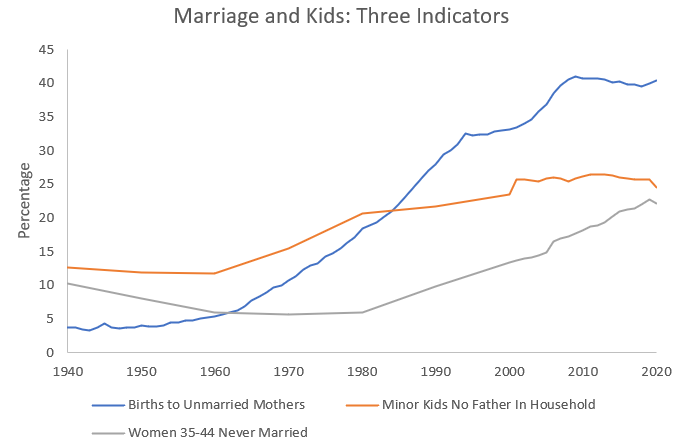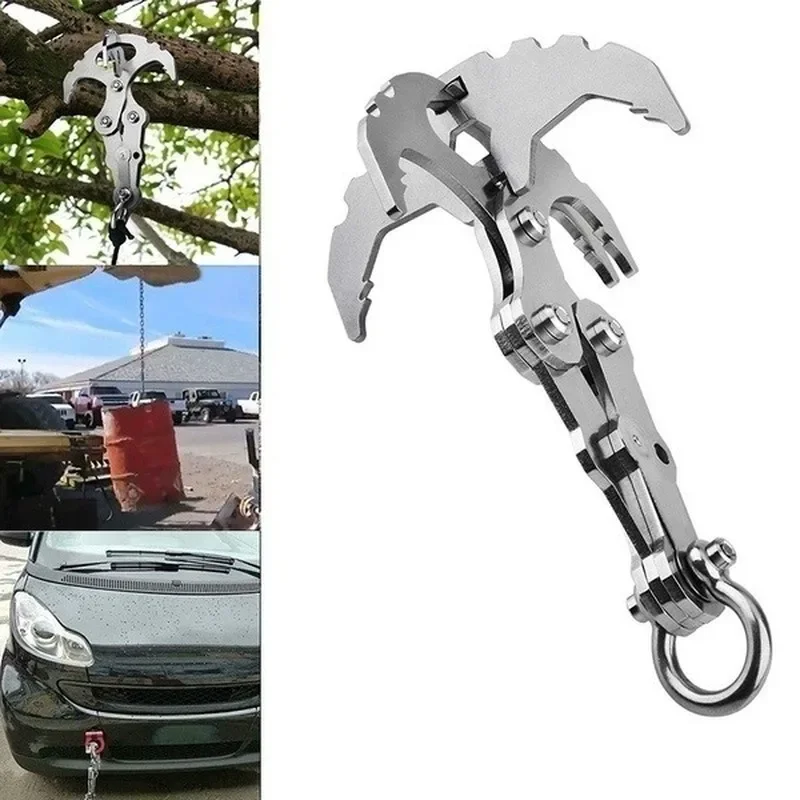The debate over single parenthood has reemerged thanks in large part to The Two-Parent Privilege, a book from economist Melissa Kearney. Restoring marriage, and especially married parenthood, is a worthwhile goal. Yet, in this essay, I would like to take a step back and explore some major theories as to why marriage fell and single motherhood rose to begin with—trends that date back half a century or more.
One can argue about the relative importance of each of the following factors, and I make no pretense of offering a comprehensive explanation of these enormous, complex social phenomena. My overarching point is this: The pro-marriage movement must grapple with the massive societal shifts that drove marriage’s historic decline—many of which are, for all practical purposes, irreversible—if they hope to make concrete plans and set realistic goals for restoring the institution through public policy.
To establish the basic trends, here are the percentages of births to unmarried women, the percentage of minor children with no father (including stepfathers and cohabiting fathers) in the household, and the percentage of women 35–44 (when female fertility starts to decline) who have never been married. They tell different versions of the same story, a collapse in two-parent families especially since 1960. The birth data are from the CDC, the marriage and household data from census surveys.
Of note is that these patterns differ markedly by race and education. Less than 30 percent of white kids but more than 70 percent of black kids are born out of wedlock, for example; among 35–44-year-old women in 2020, 18 percent of those with a B.A. or higher, but 26 percent of those with less education, were never married.
Why did this happen?
The economist Gary Becker (in the works that jumpstarted the economic analysis of family life, including A Treatise on the Family) famously pointed out that it often makes sense for household partners to “specialize,” each doing a disproportionate or even exclusive share of the things he or she excels at. This is true even among partners who are biologically identical, so long as they have different experiences and skills, and thus different comparative advantages. But for much of recent history, in large part because men and women are not biologically identical, this has meant men working for pay and women managing the home.
Yet the drivers of this pattern have weakened over time. Put simply, work outside the home used to be far more physically demanding than it is today, and work inside the home used to be far more time-intensive.
These changes are often discussed in the general context of mothers working, but they were a precondition for widespread single motherhood as well. The less life demands two specialized roles to operate a home, the less mandatory it becomes to have two parents present. Or, as the economists Adam Isen and Betsey Stevenson once argued, marriage becomes less of a necessity focused around Becker-style “production,” and more of a way to share in the consumption of disposable income.
In 1900, about two-thirds of employed Americans worked in manufacturing or agriculture. This sank to two-fifths in 1950 and less than a quarter in 2000. As agriculture and manufacturing declined, service jobs such as teaching expanded (with mandatory schooling expanding in the first half of the 20th century and college enrollment surging in the second), and the entrance of more women into the labor force—with participation for women (including the elderly) rising from 1 in 5 in 1900 to a majority starting around 1980—boosted demand for child care, restaurant meals, health care, and much else thanks to the new time demands, the added income, and the onward march of technology.
Tied into this are changes in the relative incomes of men and women. The overall gender pay gap (median earnings of women vs. men, among full-time year-round workers) fell roughly from 40% to 15% between 1960 and 2021. Less-educated men especially have seen weak-to-nonexistent wage growth, and declines in their earnings relative to women’s has been shown to contribute to declining marriage rates in that demographic.
Meanwhile, before the advent of modern technology, maintaining a household was a far more laborious task. It is not an exaggeration to say that washing machines liberated women. Jeremy Greenwood and two coauthors in a 2005 paper estimated that the typical household performed 58 hours of meal prep, laundry, and cleaning per week in 1900—a full-time job and a half. This fell to under 20 by 1975. A different analysis showed that, between 1965 and 2003, women’s overall housework time (more broadly defined, including shopping) declined from about 35 to 22 hours per week, while men’s rose from 10 to 14; on net, a couple gained about a full work day.
When housework was a demanding job and paid work often required brawn—not to mention that family sizes were larger and women more frequently pregnant due to a lack of birth control—it simply made sense for fathers to work and for mothers to handle the home. Indeed, supporting children outside of that context was difficult, resulting in a variety of workarounds in cases of premarital pregnancy, ranging from the norm of shotgun marriages (which have fallen from 43 percent of marriages in the early 1960s to under 10 percent today, by one estimate), to homes where unmarried pregnant women would live until giving their babies up for adoption. Sometimes grandparents would adopt the child, who could grow up thinking his or her mother was a much-older sister.
Culture, religion, and norms contributed immensely to all of this, of course—single motherhood was intensely stigmatized—although I would conjecture that such norms are far more likely to develop and far easier to maintain in a time when single parenthood, as we know it today, genuinely is not a viable option and this fact is obvious to everyone. They are likely to erode when it is an option, economically, for a single woman to have a baby, support the household herself, and procure child care while she’s working.
There are still, of course, surviving and perhaps immortal aspects of the old ways. Some parents, especially married mothers, still stay home with their kids; as I’ve shown using data from the American Time Use Survey, even when moms and dads both work, the dads tend to work longer hours while moms do more housework and child care. But the declining demands of housework, coupled with expanding opportunities for women in the workforce, make this division far less pronounced than it once was. It is now more attractive for married women to work—and possible for unmarried women to have kids.
The above developments explain why single motherhood is possible today in a way it wasn’t previously, but they’re perhaps not entirely compelling as an explanation of why the shift has been most dramatic at the bottom of the socioeconomic spectrum. Less educated, lower-earning men may be less attractive as marriage partners, but at the same time, higher-earning women might have the easiest time going it alone.
A recent paper from Jeanne Lafortune and Corinne Low views these dynamics through a different lens, focused on how marriage functions as a legal contract. The gist of their theory is that marriage turns wealth into “collateral” in the event of a breakup, and that this advantage of marriage persists even when marriage weakens in other ways. It’s especially valuable to married women who bear children and, even today, sacrifice more career progress than their husbands raising them. Of course, collateralizing wealth is only an advantage to those with wealth, which is why this is so valuable to our understanding of the growing education gap in marriage.
Lafortune and Low test this theory against real data. For one thing, the added security of wealth does seem to affect how married women behave: when home prices are lower in the year a couple gets married, women are more likely to specialize and reduce their paid work, because they are more likely to be homeowners with shared wealth that serves as an insurance policy. Such marriages also produce somewhat more children.
It’s also true that as the marriage contract weakens legally—something Michael Toscano explored in a previous entry in this series—the remaining benefit of collateralization rises in importance. Unilateral divorce laws provide a test of the theory because they expose partners to abandonment but don’t change the fact that wealth is split up during a divorce. In other words, they get rid of the leverage that comes with marriage except for collateralized wealth, and thus should strengthen the relationship between assets and marriage. This is in fact what the paper finds. The same pattern is evident when states step up child-support enforcement for never-married mothers. These policies grant part of the benefit of marriage—access to some of the partner’s income to raise a child—but not full access to the partner’s wealth, and thus similarly strengthen the link between wealth and marriage.
It seems unlikely that America will end unilateral divorce or adopt a policy where fathers don’t owe child support unless they have formally committed to the mother through marriage, though both ideas have found some support among conservative intellectuals over the years. Yet when the legal aspect of marriage has been reduced to a promise to share wealth—if child support is available with or without marriage, and if either party may leave a marriage at any time, almost as easily as one could dissolve any other romantic relationship—the wealthy are the ones who still have a reason to enter that contract.
The idea that an expanding welfare state drove the increase in single parenthood has long been controversial, perhaps most famously through its appearance in Charles Murray’s 1984 work Losing Ground. Interestingly, Murray’s own views on the topic have softened, as he told me when I interviewed him for a 2022 City Journal profile: “There was something in the nature of modernity that was pushing these phenomena of family breakdown over and above the welfare system.”
Today, I would summarize the evidence this way: There’s a strong circumstantial case that welfare benefits increased single parenthood to some extent, but to what extent is difficult to nail down using scientifically rigorous methods.
The circumstantial case amounts to a combination of simple facts. Welfare benefits increased alongside the increase in single motherhood; welfare benefits grew competitive with less-educated men’s wages and had rules limiting benefits primarily to single mothers; and single mothers in fact used these benefits in large numbers. In addition, the welfare theory does a decent job of matching the timing of the single-parenthood increase as well as the fact it was most pronounced among those with lower-incomes.
An analysis from the Social Capital Project found that through the safety net, “a single mother can achieve about two-thirds of the standard of living she could get from marrying a sole breadwinner at [the 30th percentile of male compensation]. The safety net would put her about one-third higher, with no additional income, than the 10th percentile of male compensation.” It also found the big run-up in benefits for female-headed households took place from 1940 to the mid-1970s, during which time benefits more than doubled and the rise of non-marital births began in earnest.
During the 1990s, this assistance changed to encourage single parents to work. Policymakers expressed a desire to encourage marriage, too, and included some marriage incentives and programs in their efforts. But the new system’s work demands were far more insistent than its marriage demands—those who failed to work lost public support, but unmarried parents didn’t—and these goals may have even worked at cross-purposes. By one study, the rising work rate of single mothers induced by welfare reform discouraged them from marrying by making them more independent.
At any rate, total safety net spending did not decline; it just shifted away from cash welfare and into other benefits such as food stamps and the Earned Income Tax Credit, and also away from non-workers in favor of low-income workers. Per my own analysis of the Current Population Survey, about half of never-married mothers with minor children received at least some income from cash welfare from the mid-1970s through the early 1990s (based on survey self-reports); this proportion fell off a cliff after the reform, but to this day, about half receive the Earned Income Tax Credit and nearly a third receive food stamps.
Quite frankly, it beggars belief that rising public support had nothing to do with the rise of single motherhood. The government in fact paid for something and got more of it. But nailing down the extent of the contribution is hard, and it may be small.
Subscribe Today
Get daily emails in your inbox
Rather than analyze national trends, the most exacting studies look at more local sources of variation in benefit levels. Most of this research was done decades ago, making this 1998 review still a decent introduction. These studies’ results are muddier, and certainly cut against the idea that single women are meticulously budgeting their potential welfare receipts before having children. If the link between growing welfare benefits and single parenthood is a bit more diffuse than that, though—if, for example, growing public support contributes, along with the other factors we’ve discussed, to a gradual and society-wide change in norms and behavior—we wouldn’t necessarily expect these kinds of studies to pick it up.
There are ways to improve American marriage on the margins, such as eliminating marriage penalties in tax and transfer programs, allowing couples to opt in to stricter marriage contracts, and improving the economic circumstances of less-educated men. Yet there is no turning back the clock to bring back the conditions that led to almost all births to occur within marriage the better part of a century ago, and few of us marriage supporters are reactionary enough to want to go back anyway.
This article is part of the “American System” series edited by David A. Cowan and supported by the Common Good Economics Grant Program. The contents of this publication are solely the responsibility of the authors.





















































